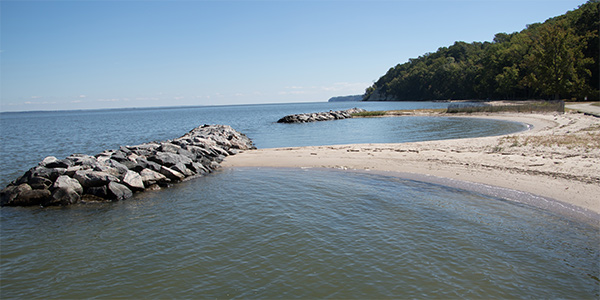
 Department of Conservation and Recreation
Department of Conservation and Recreation
Conserve. Protect. Enjoy.
 Department of Conservation and Recreation
Department of Conservation and Recreation

Shorelines are in constant states of change. The main causes of shoreline erosion are storm waves and rising sea levels. Human activity, such as agriculture and development, can drastically accelerate the natural rate of shoreline erosion. Soil type and composition also can affect shoreline erosion rates. Some Virginia shorelines have historic erosion rates of up to 30 feet per year.
The Shoreline Erosion Advisory Service, or SEAS, was established in 1980 to assist private landowners and localities in Virginia with erosion problems. The work of SEAS staff had previously been focused on tidal areas of Virginia, specifically localities from Fairfax County to the North Carolina line and from the fall line eastward. However, today, SEAS services are available in non-tidal areas of the state.
Assistance is provided free of charge.
SEAS services include:
The Chesapeake Bay shorelines and the mouths of the major rivers in Virginia are especially vulnerable to erosion. This is because of fetch. Fetch is the distance of open water over which the wind can blow. The greater the fetch distance the greater the potential wave will be during storms.
If left unmanaged, shoreline erosion can cause a drop in property values, loss of productive land, and in the worst cases, injury or loss of life.
There are also negative impacts to water quality from shoreline erosion. Fine soil particles (silt and clay) can cloud the water column and reduce the amount of sunlight that reaches the bottom. Less sunlight greatly reduces the amount of submerged aquatic vegetation, which provides critical habitat for juvenile fish and crabs.
Along with sediment, eroding shorelines also contribute nutrients to the receiving water body. Nutrients, such as nitrogen and phosphorus, naturally occur in soil. Excessive amounts of nitrogen and phosphorus can cause algal blooms and greatly lower the amount of dissolved oxygen in the water. Low oxygen levels can cause fish kills.

For years, waterfront landowners have used various methods to try to prevent shoreline erosion. Quick fixes often will not work without the proper technical expertise and site analysis. Improperly designed solutions can deprive natural beaches of their sand supply or cause the adjacent shoreline to erode at a faster rate. They may even fail. Properly designed and installed options will provide better protection and last longer than quick fixes. They will also minimize negative impacts on adjacent properties.
Shoreline Management in the Chesapeake Bay
For help with eroding shoreline, contact the engineer below.
Mike Vanlandingham
Shoreline Engineer
mike.vanlandingham@dcr.virginia.gov
804-443-1494 - office
804-466-2229 - cell
Aaron Wendt
Shoreline Engineer
aaron.wendt@dcr.virginia.gov
804-296-1701 - cell
Virginia Department of Conservation and Recreation
772 Richmond Beach Road
P.O. Box 1425
Tappahannock, VA 22560
804-443-4534 - fax

